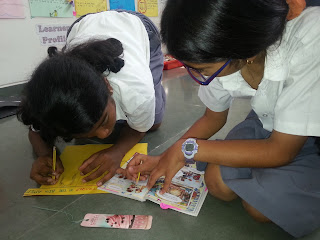Things are going great guns for Grade 5's! Apologies for not updating the blog for long.. I was really tied up with things...
The current unit for the Grade 5 is on buildings and structures. It falls under the theme 'How the world works' and the central idea is 'The designs of buildings and structures are dependent on the environmental factors and human ingenuity'. We are currently looking at the first line of inquiry: Forms of buildings and structures.
We started the unit by taking the students for a city tour. We selected the Hi - Tech area as it has many unconventionally designed buildings. The purpose of the trip was to tune then into the unit. The students also came up with many inquiry questions which were later sorted into the key concepts: Form, Function and Causation. The words of the central idea were given to them in a jumbled fashion and the students were asked to frame a meaningful sentence.
Few pictures from the trip:
After this the students conducted research about many famous buildings and structures around the world and prepared presentations for the rest of the class. We looked at the design of the building/structure, the reasons behind it's construcion and some other basic facts. The students also watched videos on the Burj Khalifa and the Akashi bridge to learn more about their construction. We learnt about the physical forces involved in constructing a building: gravity, compression and tension by watching a video and playing a quiz.
The students are doing a case study on the school campus too. For this, they were taken for a tour around the campus. They learnt about the different materials used while construction and also looked at the blueprint. They got a feel of the whole campus through the tour. Their discovery of the school campus will continue when Mr. Nuruddin (Architect) will come to the class tomorrow to answer their questions.
The students have been writing a descriptive essay on the school campus in English. They have used the data collected from the trip in the essay. Apart from this, they also have inquired into the vocabulary related to buildings and structures. They have been reading a lot of books which are conceptually or contextually connected to the unit.

There is a lot of math integration happening in the unit. The students have been learning about different geometrical shapes: points, lines, angles, 2D shapes and 3D shapes. They have learnt the classification of each of these shapes and have also done some constructions. They have been solving problems based on angles this week: complementary, supplementary, vertically opposite, corresponding and alternating angles. They have created a 'shape booklet' in which they have written examples of the different shapes in the school campus. An interesting project they are working on is the blueprint of the JA building. They have already taken the measurements. They will scale down these measurements and will come up with a detailed blueprint later this week.






In UOI, the students are soon going to form expert groups based on the different forms of buildings and structures: sky scrapers, bridges, dams and tunnels. The groups will be conducting research and experinements based on their topic and will present the same to the rest of the groups. This will also be their formative assessment.
























































